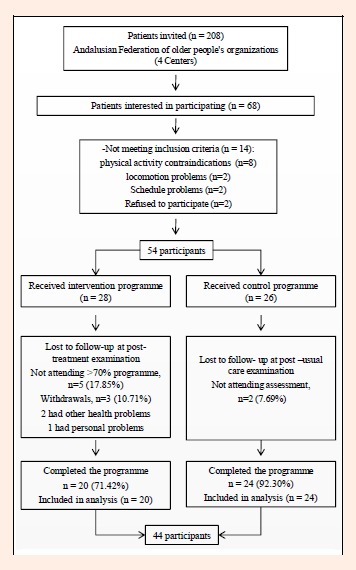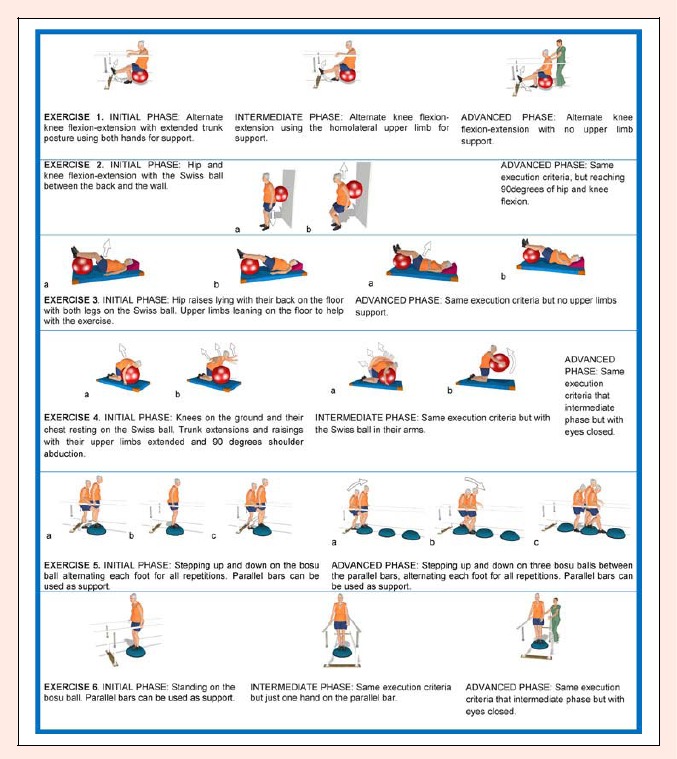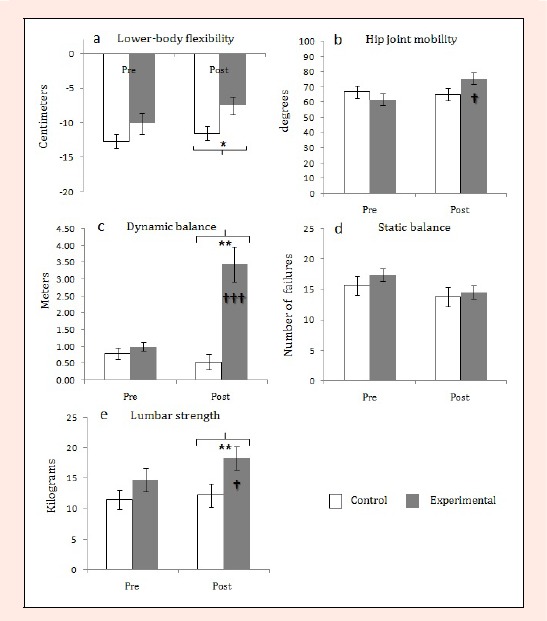Abstract
The purpose of the present study was to determine the effects of a proprioceptive training program on older adults, as well as to analyze the association between flexibility, balance and lumbar strength (physical fitness test) with balance ability and fall risk (functional balance tests). This study was a controlled, longitudinal trial with a 12-week follow-up period. Subjects from a population of older adults were allocated to the intervention group (n = 28) or to the usual care (control) group (n = 26). Subjects performed proprioceptive training twice weekly (6 specific exercises with Swiss ball and BOSU). Each session included 50 minutes (10 minutes of warm-up with slow walk, 10 minutes of mobility and stretching exercises, 30 minutes of proprioceptive exercises). The outcome variables were physical fitness (lower-body flexibility, hip-joint mobility, dynamic balance, static balance, and lumbar strength) and functional balance (Berg scale and Tinetti test). The experimental group obtained significantly higher values than the control group in lower-body flexibility, dynamic balance, and lumbar strength (p = 0.019, p < 0.001, and p = 0.034 respectively). Hip-joint mobility, dynamic balance, and lumbar strength were positively associated with balance ability (p < 0.001, p < 0.001, and p = 0.014, respectively) and the prevention of falls (p = 0.001, p < 0.001, and p = 0.017 respectively). These findings suggest that a 12-week proprioception program intervention (twice a week) significantly improves flexibility, balance, and lumbar strength in older adults. Hip-joint mobility, dynamic balance and lumbar strength are positively associated to balance ability and the risk of falls in older adults. This proprioceptive training does not show a significant improvement in hip-joint mobility or static balance.
Key points.
A 12-week proprioceptive intervention program (two times per week) significantly improves flexibility, balance, and lumbar strength in older adults.
The risk of falls and balance ability are significantly improved after a training program with Bosu and Swiss ball in older adults.
An improvement in joint mobility, dynamic balance and lumbar strength is positively associated with balance ability and improved fall risk in older adults.
A 12-week proprioceptive intervention program (two times per week) does not show a significant improvement in hip-joint mobility and static balance.
Key words: Proprioception, physical condition, training, physical qualities, swiss ball
Introduction
Falls are considered the most common geriatric syndrome (Chang et al., 2010; Legters et al., 2006) and they are often related to mobility, as well as to neurological and cardiovascular causes (Lord et al., 2003). The structural changes that occur as a result of aging imply an important decrease in physical condition (Katsura et al., 2010). These facts have a negative influence on functional balance, interfering with essential daily activities such as bathing, getting dressed, and climbing or descending stairs (Lacour, 2000). Anticipating the causes that limit functional balance can be relevant, given that around 30% of falls result in an injury that requires medical attention (Berry and Miller, 2008). Health care costs for treatment of fall-related injuries was 1.85 times higher than the cost of implementing a fall prevention program (Hektoen et al., 2009), and a few fall prevention studies reported a positive effect on the quality of life (Host et al., 2011; Vaapio et al., 2009).
Studies in older adults have shown a relation between the lack of muscle flexibility and poor walking ability and body balance (Iwamoto et al., 2009). It has been described that greater efficacy of the lumbopelvic muscles can contribute to postural stabilization (Cosio-Lima et al., 2003). Balance improvement is associated with decreased risk and fear of falling, and with an improvement in quality of life (Chang et al., 2010; Legters et al., 2006). In the last few years, several training programs based on aquatic exercises (Katsura et al., 2010), or on a peer-led model have helped subjects maintain strength and balance levels (Waters et al., 2011), thus contributing to reducing falls in older people. More precisely, proprioceptive exercises on unstable surfaces (Swiss ball or BOSU) have been shown to improve flexibility, balance and lower-limb strength in sedentary women (Sekendiz et al., 2010), as well as providing a basis for a muscle strength increase (Teixeira et al., 2010). Martínez-Amat et al. (2013) showed how a 12-week proprioception training program in older adults caused improvements in stabilometric measures such as Romberg surface and Romberg speed as recorded with unstable platforms. Westlake and Culham (2007) also reached the conclusion that, in older adults, there was a short-term enhanced postural response to proprioceptive reintegration following a sensory-specific balance exercise program. Such exercises are based on the potential increase of muscle activity produced by maintaining postural stability, as the decrease in the unstable surface contact area leads to increased muscle recruitment (Marshall and Murphy, 2006).
Although all types of training (traditional strength training, functional strength training, endurance training) can enhance physical capacity in older adults (Solberg et al., 2013), there are many studies that have found a more specific association between physical activity and balance ability (Cadore et al., 2013; Katsura et al., 2010) or risk of falling (Chang et al., 2010; Teixeira et al., 2010). Nevertheless, some other studies revealed no conclusive differences in training between stable and unstable surfaces (Uribe et al., 2010). It is important to note that most of the studies mentioned above establish a general relation between training and fall prevention. More specifically, Granacher et al. (2008) concluded that in the near future, strength training could be replaced by high-velocity forms of power training and balance training by perturbation-based training programs. Nevertheless, to our knowledge, there are no studies showing the degree of influence of proprioceptive-training-improved physical abilities (flexibility, balance, and strength) on balance ability and on the risk of falls in older adults.
In light of the research mentioned before, the purpose of the present controlled trial was to determine the effects of a 12-week proprioceptive training program on the improvement of flexibility, balance and lumbar strength (primary outcome) as well as to analyze the association between flexibility, balance and lumbar strength, and balance ability and risk of falls (secondary outcome) in older adults.
Methods
Study design
The present study was a controlled, longitudinal trial in which participants were allocated to the intervention (n = 28) or usual care (control) group (n = 26). For practical and ethical reasons, it was not possible to randomise the patients. We had an ethical obligation with the Andalusian Federation of Older People's Associations (Spain) to provide treatment to all older adults willing to participate in the study, but due to limitation of resources, we created a waiting list. Older adults from the waiting list agreed to be part of the usual care group (control group) and were offered the intervention program at the end of the intervention period. Data collected only during the control period were included in the current analysis. The research protocol was reviewed and approved by the Ethics Committee of the Master's degree in Research and Teaching in Physical Activity and Health Sciences (University of Jaén, Spain). The study was carried out from March 2010 to June 2011, following the ethical guidelines of the Declaration of Helsinki (2008 revision).
Participants
A total of 208 older adults who attended the Andalusian Federation of Older People's Associations were contacted. Sixty-eight potentially eligible older adults responded, and gave their written informed consent after receiving detailed information about the research aims and study procedures. Subjects who were 65 years or older and able to follow simple directions (e.g., left, right, up or down) were included in the study. The exclusion criteria were functional blindness (acuity level worse than 20/200) and major chronic medical or physical conditions, including rheumatoid arthritis or osteoarthritis, severe low back pain, severe lower-limb deformities, as diagnosed by a physician, which might result in the inability to ambulate independently or with the use of an assistive walking device.
A total of fourteen patients were not included in the study (eight had physical activity contraindications, two had locomotion problems, and two reported schedule problems). After the first day of baseline measurements, two patients refused to continue participating. Therefore, a final sample of 54 older adults started the study. The study flow of patients is presented in Figure 1. The baseline characteristics of participants in both the experimental and the control groups are shown in Table 1.
Figure 1.

Flow chart of subjects throughout the trial.
Table 1.
Sociodemographic and anthropometric characteristics, including balance ability and risk of falling of the participants analyzed by groups.
| Variable | Control group (n = 24) | Experimental group (n = 20) | |
|---|---|---|---|
| Age (years) | 77.0 (6.9) | 79.35 ± 7.42 | |
| Weight (kg) | 64.6 (9.4) | 62.07 ±10.84 | |
| Height (m) | 1.60 (.08) | 1.58 ± 0.09 | |
| BMI (kg/m2) | 25.4 (4.49) | 24.64 ± 2.97 | |
| Sex (%) | Female | 10 (41.7) | 9 (45) |
| Male | 14 (58.3) | 11 (55) | |
| Berg test (%) | Low balance ability | 15 (62.5) | 12 (60) |
| High balance ability | 9 (37.5) | 8 (40) | |
| Tinetti scale (%) | High risk of falling | 16 (66.7) | 11 (55) |
| Low risk of falling | 8 (33.3) | 9 (45) | |
|
Marital status (%) |
Married | 8 (33.3) | 7 (35) |
| Single | 4 (16.7) | 4 (20) | |
| Separated/Divorced/ Widowed | 12 (50) | 9 (45) | |
|
Occupational status (%) |
Housewife | 2 (8.3) | 2 (10.0) |
| Worker | - | - | |
| Unemployed | - | - | |
| Retired | 22 (91.7) | 18 (90) | |
|
Academic status (%) |
No studies | 18 (75) | 14 (70) |
| Primary education | 6 (25) | 6 (30) | |
| Secondary education | - | - | |
| Higher education | - | - | |
| Income (%) | € < 12000/year | 17 (70.8) | 15 (75) |
| € 12000 – 18000/year | 5 (20.8) | 3 (15) | |
| € > 18000/year | 2 (8.3) | 2 (10) |
Values are the mean (SD) unless otherwise indicated.
Proprioceptive interventions
The subjects in the experimental group participated in a 12-week proprioception training program, performed two days per week (Monday and Wednesday), for a total of 24 sessions. Participants in the control group performed the same amount of usual physical activity as the experimental group (2 days/week). Subjects in the control group were also requested not to change their usual levels of activity and their medication for the 12-week intervention period. All participants (both control and experimental) met weekly for an hour with the researchers to discuss topics of interest to the elderly. The exercise sessions were carefully supervised by a fitness specialist and by a physical therapist who worked with groups of 10–12 people.
Exercise sessions
Each exercise session included 50 minutes (10 minutes of warm-up with slow walk, mobility and stretching exercises, followed by 30 minutes of a proprioceptive exercises program, and finishing with 10 minutes of cool down through stretching and relaxation exercises). The training program comprised six specific proprioceptive exercises, each five minutes long, which were conducted in static and dynamic positions for a period of 30 minutes (Figure 2). The training was structured into two or three progressive phases according to the type of exercise. The initial phase comprised weeks 1-5, the intermediate phase weeks 5-8, and the advanced phase weeks 8-12.
Figure 2.

Proprioceptive exercises. Each session took 50 minutes (10-minute warm-up, 30-minute proprioceptive exercises session, and 10-minutes cool-down).
Outcome measures
Pre- and post-intervention assessment was carried out on two separate days with at least 48h between sessions. This was done in order to prevent fatigue and facilitate muscle recovery. The assessment of tender-points, lower-body flexibility, articular mobility of the hip, static and dynamic balance and lumbar strength were carried out on the first day, and Tinetti and Berg tests were performed on the second day. Both the intervention and the usual care groups were assessed the week immediately before the intervention began and the week after the end of the intervention. All measurements were performed in the same order by the same trained physiotherapist, following the testing manual.
Physical fitness (primary outcome)
Lower-body flexibility: In the “chair sit and reach” test the subject, who is seated with one leg extended, slowly bends forward, sliding the hands down the extended leg in an attempt to touch (or reach past) the toes. The number of centimeters short of reaching the toe (minus score) or reaching beyond it (plus score) was recorded. Two trials were measured with each leg, and the best value of each leg was registered. The average of both legs was used in the statistical analysis. The validity of this test in old adults is well established (Rikli and Jones, 1999).
Hip-joint mobility: Hip-joint mobility was measured as active movements. A standard steel goniometer was used to assess hip-joint mobility. Subjects were instructed to adopt a standing position with a straight back in order to facilitate measuring hip abduction and adduction. The fulcrum of the goniometer was placed at the lateral of the coxofemoral joint. The fixed arm of the goniometer was aligned with the axis of the femur by using the greater trochanter as a reference point. The arm was aligned with the lumbar spine. Subjects flexed their trunk to touch their feet with both hands while keeping their back straight. Two measurements were performed, and the average value was used for the statistical analysis. The validity of this test for screening old adults for risk for falling was well established by Walker et al., (1984).
Dynamic balance: An adaptation of the timed “get up and go” test (Rikli and Jones, 1999) was performed. For this purpose, we used a 240 cm wooden beam (5 cm wide) placed 5 cm above the floor. Two square platforms (20 x 20 cm) were positioned at both ends of the beam, and subjects were required to walk on the beam from one end to the other. Once the platform had been reached, the participant had to perform a 180-degree turn without touching the ground and walk in the opposite direction. We measured the distance (in meters) covered during 45 seconds or until the participant touched the ground. Three attempts were allowed and the best value was taken in each case.
Static balance: This was assessed with the “blind flamingo” test (Rodriguez et al., 1998). The number of trials needed to stand for 30 seconds in the static position was recorded, and the chronometer was stopped whenever the patient did not comply with the protocol conditions. One trial was performed for each leg, and the average of both values was selected for analysis.
Lumbar strength: Lumbar muscular strength was measured using a digital dynamometer (Lumbacord, 2012) as previously described in the literature (Parkkola et al., 1992). Patients performed the test twice, with a one-minute rest period between measures. The best value was registered.
Functional balance (secondary outcome)
Berg balance scale (balance ability): The Berg balance scale was used to assess balance ability of the subjects. This is a performance-based measure of balance consisting of 14 observable tasks common to daily life activities and used to evaluate functional balance (Berg et al., 1989). The maximum score that can be achieved is 56, and each item possesses an ordinal scale of five alternatives, which varies from zero to four points. The test is simple, easy to administer and accompanies the evolution of older patients. It only requires a ruler and a watch and takes approximately 15 minutes to perform (Miyamoto et al., 2004). A score lower than or equal to 45 is considered evidence of altered balance (Whitney et al., 1998). The validity of this test for screening the balance ability of older adults is well established (Badke et al., 2011).
Tinetti scale (risk of falls): We also assessed the gait and balance abilities of participants using the Tinetti scale scale (Tinetti et al., 1994). For gait evaluation, the subject stands with the examiner, walks across the room, first at “usual” pace, then back at “rapid, but safe” pace (utilizing usual walking aids) and the following tasks are scored (0 to 2, indicating highest to lowest level of impairment respectively): initiation of gait, step length and height, step symmetry, step continuity, path, trunk sway and walking stance. For balance evaluation, the subject is seated in a hard, armless chair and the following maneuvers are tested (score, 0, 1 or 2): sitting balance, arises, attempts to arise, immediate standing balance (first 5 s), standing balance, nudged, eyes closed, turning 360° and sitting down. The maximum sum-score of both gait and balance components are 28 points. Patients who score below 24 are at risk for falls, and the risk of falls is high with a score below 19. The validity of this test for screening old adults at risk of falling is well established (Raiche et al., 2000). Higher scores represent a greater lower level of fall risk.
Statistical analysis
Student's t test and chi-squared test were used to compare anthropometric and demographic variables respectively, between the experimental and the control groups. We used a two-factor (group and time) analysis of covariance (ANCOVA) with repeated measures to assess the training effects on outcome measures after adjusting for age. For each variable, P value was calculated according to the group (inter-subjects), time (intra-subjects) and interaction group x time effect. Multiple comparisons were adjusted by Bonferroni's correction. Linear regression was used to assess the association between flexibility, balance and strength (predictive variables) and the balance ability and the risk of falls (dependent variables). Regression analyses were separately carried out for each dependent and predictive variable after adjusting for age. P < 0.05 was used to identify statistical significance. The percentage of change after training was calculated as: [(post-measurement – pre-measurement) / pre-measurement]) × 100. Analyses were performed using the Statistical Package for Social Sciences (SPSS, v. 19.0 for Windows, Chicago).
Results
The present study shows that a low-to-moderate two-month proprioceptive intervention training program was well tolerated and did not have any deleterious effects on the health of participants. There were no differences between groups in any of the variables at the beginning of the study.
Analysis of variance
Measures of flexibility (lower-body flexibility and hip-joint mobility), balance (dynamic and static balance), and lumbar strength: The results of the physical fitness tests, expressed as mean (±SD), are presented in Figure 3. The trained subjects significantly improved their lower-body flexibility (p = 0.018, Eta2 = 0.129, (Figure 3a), covered a greater distance over the wooden beam (dynamic balance) (p < 0.001, Eta2 = 0.441, Figure 3b) and improved their lumbar strength (p = 0.009, Eta2 = 0.15, Figure 3e) compared to non-trained subjects (Figures 3a, 3c, 3e). There were no significant differences in hip-joint mobility and static balance between the experimental and the control groups (p > 0.05, Figures 3b, 3d). The inter-subject effect showed a group × time interaction for dynamic balance test (p < 0.001, Eta2 = 0.528), the lumbar strength test (p = 0.008, Eta2 = 0.160), and the hip-joint mobility test (p < 0.001, Eta2 = 0.572). In all three cases, significant differences were observed in the participants who performed proprioceptive training (p < 0.001, p = 0.036, p < 0.042, respectively).
Figure 3.

Average results for flexibility (a, b), balance (c, d) and lumbar strength (e) tests after a 12-week proprioceptive training program.> Inter-group differences within the same measurement, * p < 0.05, ** p < 0.001. Intra-group differences in pre- vs. post-intervention: † p < 0.05, ††† p < 0.001.
Measures of balance ability (Berg scale) and the risk of falls (Tinetti test): The results of the balance ability and the risk of falls assessment (mean±SD) are presented in Table 2. Berg scale and Tinetti test scores in older adults were significantly higher for the trained group (p < 0.001). Post hoc analysis of the group × time interaction revealed that the experimental group experienced a significant improvement in both balance ability (p < 0.001) and the risk of falls (p < 0.001). No significant differences were observed in baseline control vs. experimental groups. For the Berg scale and the Tinetti test, higher scores represent a better balance ability and lower risk of falls, respectively.
Table 2.
Effects of a 12-week intervention on balance ability (Berg scale) and the risk of falling (Tinetti test).
| Group | Pre | Post | Group effect | Time effect | Interaction effect | |
|---|---|---|---|---|---|---|
|
Berg test |
Control (n=24) | 37.7 (7.7) | 36.8 (7.9) | P = .001 F(1.41) = 11.69 Eta2 = .222 |
P = .852 F(1.41) = .035 Eta2 = .002 |
P < 0.001 F(1.41) = 74.42 Eta2 = .645 |
| Training (n=20) | 42.3 (8.0) | 47.2 (6.0) ***††† | ||||
|
Tinetti scale |
Control (n=24) | 20.3 (5.7) | 19.9 (5.8) | P = .002 F(1.41) = 10.74 Eta2 = .208 |
P = .906 F(1.41) = .014 Eta2 = .001 |
P < .001 F( 1.41) = 58.19 Eta2 = .587 |
| Training (n=20) | 22.9 (3.7) | 26.3 (2.1) ***††† |
Data expressed as mean (SD).
*** p<0.001 compared to the control group.
††† p<0.001 compared to pre-measurement values.
Linear regression analysis
The results of the linear regression analysis showing the association between flexibility, balance and strength (predictive variables) and the balance ability and the risk of falls (dependent variables) after adjusting for age are provided in Table 3. Hip-joint mobility, dynamic balance and lumbar strength were positively associated with balance ability (Berg scale) in both pre- (p = 0.001, p = 0.011, and p = 0.049, respectively) and post-intervention measurements (p < 0.001and p = 0.014, respectively). A significantly association was observed between the same predictive variables and fall risk (Tinetti test) in post-intervention measurements (p = 0.001, p < 0.001, and p = 0.017 respectively), but not in pre-intervention measurements (p > 0.05).
Table 3.
Regression analysis [unstandardized beta and standard error (SE)] showing the association between flexibility, balance and power (predictive variables), and Berg scale of balance ability and Tinetti test for risk of falling (dependent variables) after adjusting for age.
| Pre | Berg scale | Tinetti test | ||||||
|---|---|---|---|---|---|---|---|---|
| ß | S.E. | r | P | ß | S.E. | r | P | |
| General muscular flexibility | .221 | .214 | .174 | .307 | .128 | .133 | .184 | .340 |
| Hip joint mobility | .202 | .059 | .387 | .001 | .070 | .040 | .284 | .087 |
| Dynamic balance | .596 | 2.333 | .387 | .011 | 2.091 | 1.376 | .254 | .136 |
| Static balance | .104 | .193 | .105 | .594 | -.085 | .150 | -.140 | .574 |
| Lumbar power | .308 | .152 | .307 | .049 | .186 | .095 | .312 | .056 |
| Post | ||||||||
| General muscular flexibility | .444 | .229 | .287 | .062 | .216 | .144 | .228 | .142 |
| Hip joint mobility | .309 | .055 | .663 | <.001 | .138 | .040 | .477 | .001 |
| Dynamic balance | .570 | .788 | .671 | <.001 | 2.356 | .547 | .558 | <.001 |
| Static balance | .286 | .214 | .204 | .189 | -.241 | .148 | -.247 | .111 |
| Lumbar power | .358 | .139 | .372 | .014 | .216 | .087 | .362 | .017 |
Discussion
The results of the present study revealed that a 12-week proprioceptive training program significantly increases lower-body flexibility, dynamic balance, and lumbar strength in older adults, but no significant improvements were apparent in hip-joint mobility and static balance. Participants in the proprioceptive training group showed significant improvements in balance ability and risk of falling (Berg scale and Tinetti test, respectively). Hip-joint mobility, dynamic balance and lumbar strength were positively associated with balance ability and the reduction of fall risk in older adults. No significant association was found between lower-body flexibility and static balance.
Previous studies have concluded that exercises focused on improving flexibility constitute an efficient method for preventing falls in older adults, increasing functional mobility (Skelton, 2001). Iwamoto et al. (2009) described an association between body balance and a lack of flexibility in quadriceps and hamstrings muscles. Nevertheless, some contradicting information exists: Paterson et al. (2010) concluded that while joint flexibility may decrease with age, with the potential to affect normal daily function, older adults do maintain the ability to improve flexibility through stretching exercises. In addition, Stathokostas et al. (2012) suggested that while flexibility-specific interventions may have effects on range of motion in older adults, there is conflicting information regarding the relationship between flexibility interventions and functional outcomes, and between flexibility interventions and daily functioning. Our results partially agree with these authors as the experimental group significantly improved hip-joint mobility (22.5% in the goniometer) and lower-body flexibility (25.73% in the sit and reach test). A significant relation between fall risk (higher scores in Tinetti test) and balance ability was observed, although it did not extend to lower-body flexibility.
Regarding dynamic balance, our results show an improvement of 245%, and a very strong positive relation with balance ability and a lower risk of falling was observed. Legters et al. (2006) and Chang et al. (2010) described effective results for dynamic balance improvement and fall prevention when a loss of stability was observed in older adults. Several studies have concluded that proprioceptive training in the older population can lead to an improvement in inter- and intra-muscular coordination and dynamic balance, but the association with balance ability and fall prevention has not been identified (Sekendiz et al., 2010). In the static balance analysis, our results are consistent with other studies (Lord et al., 2003; Morrison et al., 2010). We also observed an improvement of 16.62% after proprioceptive training, although it was not significant. A few studies have shown an improvement in postural stability, and described a statistical association with the risk of falls (Vaapio et al., 2009). A similar study (ability to stand unassisted for 5 seconds on one leg in older adults) concluded that one-leg balance appears to be a significant and easy-to-administer predictor of injurious falls, but not of all falls (Vellas et al., 1997). We think that the discrepancy between our results and those of the mentioned studies could be attributed to the methods used to assess the improvement of this ability.
The experimental group exhibited a significant improvement of 24.1% in lumbar strength. These results are higher than the 20% improvement caused by four months of lumbar resistance exercise in older adults with chronic low back pain (Vincent et al., 2013). Generally speaking, our results are similar to those described in other studies that indicate that resistance exercise in older adults increases bone mineral density (Whiteford et al., 2010) and decreases the fatty infiltration of muscle and the risk of developing musculoskeletal diseases (Liu et al., 2010). Nevertheless, not many studies have shown the association between Swiss ball training aimed to increase muscle strength and the reduction of the risk of falls (Sekendiz et al., 2010). According to our results, we can state that greater lumbar strength is significantly associated with balance ability and the prevention of falls.
After the intervention, the percentage of older adults with high balance alteration, (Berg balance scale) and high risk of falling (Tinetti test) changed from 60% to 30% and from 55% to 10%, respectively. Our results are similar to those observed by Sekendiz et al. (2010), showing that proprioceptive training is effective to decrease reaction time in certain situations that can lead to falls, such as walking over obstacles (Katsura et al., 2010). Moreover, proprioceptive exercises allow an individual to better maintain knee stability during a static position, and this sensation improves knee coordination and precision, improving ankle joint control and speed (Lin et al., 2007).
Several limitations should be considered in interpreting the results of this study. Firstly, due to ethical reasons, the participants were not randomized into the intervention and usual care groups. Secondly, balance ability and fall risk were assessed by indirect tests (Berg and Tinetti tests). In an older population, walking speed and mobility restrictions can show high differences in a short period of time, which cannot be controlled (Manini et al., 2010).
Conclusion
In summary, a 12-week proprioception program intervention (two times per week) significantly improves flexibility, balance, and lumbar strength in older adults. Hip-joint mobility, dynamic balance, and lumbar strength are positively associated to balance ability and to fall risk in older adults. This proprioceptive training does not cause significant improvement in hip-joint mobility and static balance. Future research might determine whether longer and more intense programs are necessary to induce significant improvements in hip-joint mobility and static balance in older adults.
Acknowledgments
The authors would like to thank the management and staff at the Sebastián Estepa Llaurens retirement home and centers, as well as all the participants for their collaboration in this study. This study was funded by Research Group HUM 943 Laboratory and Master's degree in Research and Teaching in Physical Activity and Health Sciences (University of Jaén, Spain).
Biographies

Emilio J. MARTÍNEZ-LÓPEZ
Employment
Professor of Physical Education. Department of Musical, Plastic and Corporal Expression Didactic. Research Group HUM 943 laboratory. Universidad de Jaén (Spain).
Degree
PhD
Research interests
Young obesity, fitness training, fitness test, didactic of physical education
E-mail: emilioml@ujaen.es

Fidel HITA-CONTRERAS
Employment
Department of Health Sciences, University of Jaén (Spain).
Degree
MD
Research interests
Sports and health training, fitness training, young obesity.
E-mail: fhita@ujaen.es
Pilar M. JIMÉNEZ.LARA
Employment
Collaborator of Department of Health Sciences, University of Jaén (Spain).
Degree
MSc
Research interests
Sports and health training, fitness training, young obesity.
E-mail: fisiolara882@hotmail.com

Pedro LATORRE ROMÁN
Employment
Professor of Physical Education. Department of Musical, Plastic and Corporal Expression Didactic. Research Group HUM 943 laboratory. Universidad de Jaén (Spain).
Degree
PhD
Research interests
Young obesity, fitness training, fitness test, didactic of physical education
E-mail: platorre@ujaen.es

Antonio MARTÍNEZ-AMAT
Employment
Department of Health Sciences, University of Jaén (Spain).
Degree
PhD
Research interests
Sports and health training, fitness training, young obesity.
E-mail: amamat@ujaen.es
References
- Badke M.B., Sherman J., Boyne P., Page S., Dunning K. (2011) Tongue-based biofeedback for balance in stroke: results of an 8-week pilot study. Archives of Physical Medicine and Rehabilitation 92(9), 1364-1370 [DOI] [PubMed] [Google Scholar]
- Berg K., Wood-Dauphinée S., Williams J.I., Gayton D. (1989) Measuring balance in the elderly: preliminary development of an instrument. Physiotheraphy Canada 41, 304-311 [Google Scholar]
- Berry S.D., Miller R.R. (2008) Falls: epidemiology, pathophysiology, and relationship to fracture. Current Osteoporosis Reports 6, 149-154 [DOI] [PMC free article] [PubMed] [Google Scholar]
- Cadore E.L., Rodríguez-Mañas L., Sinclair A., Izquierdo M. (2013) Effects of different exercise interventions on risk of falls, gait ability, and balance in physically frail older adults: a systematic review. Rejuvenation Research 16(2), 105-114 [DOI] [PMC free article] [PubMed] [Google Scholar]
- Chang N.T., Chi L.Y., Yang N.P., Chou P. (2010). The impact of falls andfear of falling on health-related quality of life in Taiwanese elderly. Journal of Community Health Nursing 27(2), 84-95 [DOI] [PubMed] [Google Scholar]
- Cosio-Lima M., Reynolds K. L., Winter C., Paolone V., Jones M. T. (2003) Effects of physioball and conventional floor exercises on early phase adaptations in back and abdominal core stability and balance in women. Journal of Strength and Conditioning Research 17(4), 721-725 [DOI] [PubMed] [Google Scholar]
- Granacher U., Zahner L., Gollhofer A. (2008) Strength, power, and postural control in seniors: Considerations for functional adaptations and for fall prevention. European Journal of Sport Science 8(6), 325-340 [Google Scholar]
- Hektoen L.F., Aas E., Luras H. (2009) Cost-effectiveness in fall prevention for older women. Scandinavian Journal of Public Health 37, 584-589 [DOI] [PubMed] [Google Scholar]
- Host D., Hendriksen C., Borup I. (2011) Older people’s perception of and coping with falling, and their motivation for fall-prevention programmes. Scandinavian Journal of Public Health 39, 742-748 [DOI] [PubMed] [Google Scholar]
- Iwamoto J., Suzuki H., Tanaka K., Kumakubo T., Hirabayashi H., Miyazaki Y., Sato Y., Takeda T., Matsumoto H. (2009). Preventative effect of exercise against falls in the elderly: a randomized controlled trial. Osteoporosis International 20(7), 1233-1240 [DOI] [PubMed] [Google Scholar]
- Katsura Y., Yoshikawa T., Ueda S.Y., Usui T., Sotobayashi D., Nakao H., Sakamoto H., Okumoto T., Fujimoto S. (2010). Effects of aquatic exercise training using water-resistance equipment in elderly. European Journal of Applied Physiology 108(5), 957-964 [DOI] [PubMed] [Google Scholar]
- Lacour J.R. (2000) Aging and physical capacity. Soins Gerontologie 24, 4-7 [PubMed] [Google Scholar]
- Legters K., Verbus N.B., Kitchen S., Tomecsko J., Urban N. (2006) Fear of falling, balance confidence and health-related quality of life in individuals with postpolio syndrome. Physiotherapy Theory and Practice 22(3), 127-135 [DOI] [PubMed] [Google Scholar]
- Lin D.H., Lin Y.F., Chai H.M., Han Y.C., Jan M.H. (2007). Comparison of proprioceptive functions between computerized proprioception facilitation exercise and closed kinetic chain exercise in patients with knee osteoarthritis. Clinic Rheumatology 26, 520-528 [DOI] [PubMed] [Google Scholar]
- Liu T., Nagamatsu L.S., Graf P., Beattie B.L., Ashe M.C., Handy T.C. (2010) Resistance training and executive functions: a 12-month randomized controlled trial. Archives of International Medicine 170(2), 170-178 [DOI] [PMC free article] [PubMed] [Google Scholar]
- Lord S.R., March L.M., Cameron I.D., Cumming R.G., Schwarz J., Zochiling J., Chen J.S., Makaroff J., Sitoh Y.Y., Lau T.C., Brnabic A., Sambrook P.N. (2003) Differing risk factors for falls in nursing home and intermediate-care residents who can and cannot stand unaided. Journal of American Geriatric Society 51(11), 1645-1650 [DOI] [PubMed] [Google Scholar]
- Manini T.M., Newman A.B., Fielding R., Blair S.N., Perri M.G., Anton S.D., Goodpaster B.C., Katula J.A., Rejeski W.J., Kritchevsky S.B., Hsu F.C., Pahor M., King A.C., Life Research Group. (2010) Effects of exercise on mobility in obese and non obese older adults. Obesity 18(6), 1168-1175 [DOI] [PMC free article] [PubMed] [Google Scholar]
- Martínez-Amat A., Hita-Contreras F., Lomas-Vega R., Caballero-Martínez I., Alvarez P.J., Martínez-López E.J. (2013) effects of 12-week proprioception training program on postural stability, gait, and balance in older adults: A controlled clinical trial. Journal of Strength and Conditioning Research 27(8), 2180-2188 [DOI] [PubMed] [Google Scholar]
- Marshall P., Murphy B. (2006) Increases deltoid and abdominal muscle activity during swiss ball bench press. Journal of Strength and Conditioning Research 20(4), 745-750 [DOI] [PubMed] [Google Scholar]
- Miyamoto S.T., Lombardi J.I., Berg K.O., Ramos L.R., Natour J. (2004) Brazilian version of the Berg balance scale. Brazilian Journal of Medical and Biological 37, 1411-1421 [DOI] [PubMed] [Google Scholar]
- Morrison S., Colberg S.R., Mariano M., Parson H.K., Vinik A.I. (2010) Balance training reduces falls risk in older individuals with type 2 diabetes. Diabetes Care 33(4), 748-755 [DOI] [PMC free article] [PubMed] [Google Scholar]
- Parkkola R., Kujala U., Rytökoski U. (1992) Response of the trunk muscles to training assessed by magnetic resonance imaging and muscle strength. European Journal of Applied Physiology and Occupational Physiology 65(5), 383-387 [DOI] [PubMed] [Google Scholar]
- Paterson D.H., Warburton D.E.R. (2010) Physical activity and functional limitations in older adults: a systematic review related to Canada's Physical Activity Guidelines. International Journal of Behavioral Nutrition and Physical Activity 7, 38. [DOI] [PMC free article] [PubMed] [Google Scholar]
- Raiche M., Hebert R., Prince F., Corriveau H. (2000) Screening older adults at risk of falling with the Tinetti balance scale. Lancet 356, 1001-1002 [DOI] [PubMed] [Google Scholar]
- Rikli R.E., Jones J. (1999) Development and validation of a functional fitness test for community residing older adults. Journal of Aging and Physical Activity 7, 129-161 [Google Scholar]
- Rodriguez F.A., Gusi N., Valenzuela A., Nacher S., Nogues J., Marina M. (1998). Evaluation of health-related fitness in adults (I): background and protocols of the AFISAL-INEFC Battery [in Spanish]. Apunts. Educación Física y Deportes 52, 54-76 [Google Scholar]
- Sekendiz B., Cug M., Korkusuz F. (2010) Effects of Swiss-ball core strength training on strength, endurance, flexibility, and balance in sedentary women. Journal of Strength and Conditioning Research 24(11), 3032-3040 [DOI] [PubMed] [Google Scholar]
- Skelton D. (2001) Effects of physical activity on postural stability. Age and Ageing 30(S4), 33-39 [DOI] [PubMed] [Google Scholar]
- Solberg P.A., Kvamme N. H., Raastad T., Ommundsen Y., Tomte S. E., Halvari H., Loland N.W., Hallén J. (2013) Effects of different types of exercise on muscle mass, strength, function and well-being in elderly. European Journal of Sport Science 13(1), 112-125 [Google Scholar]
- Stathokostas L., Little R., Vandervoort A.A., Paterson D. (2012) Flexibility training and functional ability in older adults: A systematic review. Journal of Aging Research Article ID: 306818, 30.pages [DOI] [PMC free article] [PubMed] [Google Scholar]
- Teixeira L.E., Silva K.N., Imoto A.M., Teixeira T.J., Kayo A.H., Montenegro-Rodrigues R., Peccin M.S., Trevisani V.F. (2010) Progressive load training for the quadriceps muscle associated with proprioception exercises for the prevention of falls in postmenopausal women with osteoporosis: a randomized controlled trial. Osteoporosis International 21(4), 589-596 [DOI] [PubMed] [Google Scholar]
- Tinetti M. E., Baker D. I., McAvay G., Claus E.B., Garrett P., Gottschalk M., Koch M.L., Trainor K., Horwitz R.I. (1994). A multifactorial intervention to reduce the risk of falling among elderly people living in the community. The New England Journal of Medicine 331, 821-827 [DOI] [PubMed] [Google Scholar]
- Uribe B.P., Coburn J.W., Brown L.E., Judelson D.A., Khamoui A.V., Nguyen D. (2010) Muscle activation when performing the chest press and shoulder press on a stable bench vs. a Swiss ball. Journal of Strength and Conditioning Research 24(4), 1028-1033 [DOI] [PubMed] [Google Scholar]
- Vaapio S.S., Salminen M.J., Ojanlatva A., Kivela S.L. (2009). Quality of life as an outcome of fall prevention interventions among the aged: a systematic review. European Journal of Public Health 19(1), 7-15 [DOI] [PubMed] [Google Scholar]
- Vellas B.J., Wayne S., Romero L., Baumgartner R.N. (1997) One-leg balance is an important predictor of injurious falls in older patients. Journal of the American Geriatrics Society 7(45), 735-738 [DOI] [PubMed] [Google Scholar]
- Vincent H.K., Vincent K.R., Seay A.N., Conrad B.P., Hurley R.W., George S.Z. (2013) Back strength predicts walking improvement in obese, older adults with chronic low back pain. The Journal of Injury, Function, and Rehabilitation S1934-1482(13) 1148-1149 [DOI] [PMC free article] [PubMed] [Google Scholar]
- Walker J.M., Sue D., Miles-Elkousy N., Ford G., Trevelyan H. (1984) Active mobility of the extremities in older subjects. Physical Therapy 64(6), 919-923 [DOI] [PubMed] [Google Scholar]
- Waters D. L., Hale L. A., Robertson L., Hale B. A., Herbison P. (2011). Evaluation of a peer-led falls prevention program for older adults. Archives of Physical Medicine and Rehabilitation 92, 1581-1586 [DOI] [PubMed] [Google Scholar]
- Westlake K.P., Culham E.G. (2007) Sensory-specific balance training in older adults: effect on proprioceptive reintegration and cognitive demands. Physical Therapy 87(10), 1274-1283 [DOI] [PubMed] [Google Scholar]
- Whiteford T.R., Ackland S.S., Dhaliwal A.P., James J.J., Woodhouse R., Price R.L., Kerr D.A. (2010) Effects of a 1-year randomized controlled trial of resistance training on lower limb bone and muscle structure and function in older men. Osteoporosis International 21, 1529-1536 [DOI] [PubMed] [Google Scholar]
- Whitney S.L., Poole J.L., Cass S.P. (1998) A review of balance instruments for older adults. American Journal of Occupational Therapy 52, 666-671 [DOI] [PubMed] [Google Scholar]


